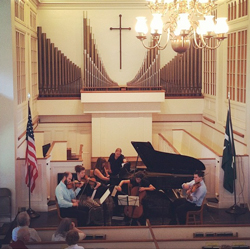by Robert Rollin

The quintet opened full force to an amazingly harmonically rich and brilliant tutti. The small hall resonated with the group’s fine sound. At the onset of the second theme, the cello and viola took the lead in a plaintively beautiful question and answer dialogue. The performance was worthy of this masterpiece. When the piano did not preside, it always had lovely passage work accompanying the strings. The wonderful late Romantic chromatic harmony, often borrowed from parallel keys, kept the music pulsating forcefully.
The minor slow movement was a seven-part rondo (ABACABA). It assumed the air of a haunting funeral march, whose beginning was heralded by a simple two-bar piano unison passage. After the main theme begins and circulates among the string instruments, the piano unison reappears in an offset, shortened version, and acts as a foil to the very regular phrasing. The wistfully contrasting B idea (in the parallel major key) has complex rhythms. The C, an intensively agitated theme dominated by the piano’s tortuously curvaceous, rapid staccato triplets, provides the movement’s greatest excitement. The group negotiated these complex moods skillfully and with élan.
The lively Scherzo, marked Molto vivace, had two trios, adding up to three
separate breakneck themes. Trio I introduced a canonic idea in the strings supported by rapid piano passagework. Trio II had an unusual change to two-four meter, though the beat remained the same. The duple meter created an acceleration that sped the movement to its conclusion. Piano solo and strings both carried these lively sixteenth notes. The Finale, marked Allegro ma non troppo, continued the energetic duple grouping and was quite contrapuntal. After some fugato passages it launched itself into a double fugue as coda. One of the two subjects was a cyclical return to the first-movement opening theme. The group had fabulous ensemble, playing with poise, great expression, and producing a stunning performance.
Mezzo Soprano Margaret Karam appeared in Johannes Brahms’s Two Songs for Alto, Viola, and Piano, with cellist Erica Snowden playing an arranged version. Elizabeth DeMio played the piano part. The poet, Friedrich Rückert, was a major Romantic poet whose verses were also set to great musical effect by Mahler. The first song, Gestillte Sehnsucht (Silent Longing), speaks of the gentle fluttering sounds of birds, and the author’s need for rest. This is death’s eternal rest. As in Goethe’s Wandrers Nachlied (Wanderers Night Song), here, the birds signify peace and repose. The second song, Geistliches Wiegenlied (Spiritual Lullaby), depicts a mother silencing the treetops so her child can sleep. Karam’s gentle rendition was delicate, and Snowden’s wonderful cello sound reverberated beautifully. However, leaving its lid fully open caused the piano to overbalance the singer at times.
The concert opened with bassoonist Mark DeMio’s performance of two twentieth-century gems. Accompanied by his talented wife, he played Alexandre Tansman’s Suite for Bassoon and Piano. All three short movements were delightful. The Introduction et Allegro began with a slow French overture-like section, immediately followed by a sprightly fast movement that displayed DeMio’s wonderful dark bassoon sound. The stately Sarabande led to a syncopated Scherzo full of interesting rhythms. Edward Elgar’s Romance in D Minor, Op. 62 was a London Symphony reminiscence written for the group’s principal bassoonist. It was challenging, lyrical, and was superbly played by the husband and wife duo.
Instagram photo by Maggie Morrison.
Published on ClevelandClassical.com August 6, 2013
Click here for a printable version of this article.



